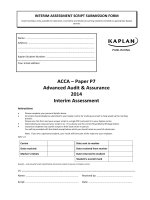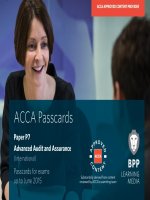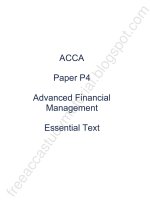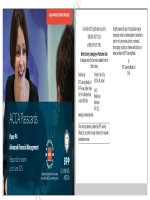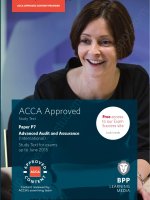2015 ACCA p7 INT essential text KAPLAN
Bạn đang xem bản rút gọn của tài liệu. Xem và tải ngay bản đầy đủ của tài liệu tại đây (10.37 MB, 478 trang )
m
freeaccastudymaterial.blogspot.com
co
ot.
l.b
log
ACCA
sp
Paper P7 (INT/UK)
ria
ate
Advanced Audit and
Assurance
ym
Essential Text
fre
ea
cc
as
tud
freeaccastudymaterial.blogspot.com
sp
ot.
co
m
freeaccastudymaterial.blogspot.com
l.b
log
British library cataloguinginpublication data
Published by:
Kaplan Publishing UK
Unit 2 The Business Centre
Molly Millars Lane
Wokingham
Berkshire
RG41 2QZ
ym
© Kaplan Financial Limited, 2014
ate
ria
A catalogue record for this book is available from the British Library.
as
tud
The text in this material and any others made available by any Kaplan Group company does not
amount to advice on a particular matter and should not be taken as such. No reliance should be
placed on the content as the basis for any investment or other decision or in connection with any
advice given to third parties. Please consult your appropriate professional adviser as necessary.
Kaplan Publishing Limited and all other Kaplan group companies expressly disclaim all liability to any
person in respect of any losses or other claims, whether direct, indirect, incidental, consequential or
otherwise arising in relation to the use of such materials.
Printed and bound in Great Britain.
Acknowledgements
cc
We are grateful to the Association of Chartered Certified Accountants and the Chartered Institute of
Management Accountants for permission to reproduce past examination questions. The answers
have been prepared by Kaplan Publishing.
fre
ea
All rights reserved. No part of this publication may be reproduced, stored in a retrieval system, or
transmitted, in any form or by any means, electronic, mechanical, photocopying, recording or
otherwise, without the prior written permission of Kaplan Publishing.
ii
KAPLAN PUBLISHING
freeaccastudymaterial.blogspot.com
Contents
Page
Regulation in a global economy
Chapter 2
Code of ethics and conduct
Chapter 3
Professional appointments
Chapter 4
Quality control
Chapter 5
Advertising, publicity, obtaining professional
work and fees
73
Chapter 6
Tendering
87
Chapter 7
Money laundering
Chapter 8
Professional responsibilities and liabilities
105
Chapter 9
Planning, materiality and assessing the risk of
misstatement
139
Chapter 10
Group and transnational audits
179
Chapter 11
Evidence
213
Chapter 12
Completion
Chapter 13
Auditors’ reports
269
Chapter 14
Reports to those charged with governance
297
Chapter 15
Other assignments
307
Chapter 16
Prospective financial information
327
Chapter 17
Audit of social, environmental and integrated
reporting
343
Chapter 18
Forensic audits
363
Chapter 19
Outsourcing and internal audit
375
Chapter 20
UK syllabus only: Auditing aspects of insolvency 385
Chapter 21
INT syllabus only: Audit of performance
information in the public sector
1
sp
15
43
ym
ate
ria
l.b
log
51
as
tud
cc
ea
fre
ot.
Chapter 1
co
m
freeaccastudymaterial.blogspot.com
95
233
403
iii
KAPLAN PUBLISHING
freeaccastudymaterial.blogspot.com
Chapter 23
Additional practice questions
413
co
Financial reporting revision
417
fre
ea
cc
as
tud
ym
ate
ria
l.b
log
sp
ot.
Chapter 22
m
freeaccastudymaterial.blogspot.com
iv
KAPLAN PUBLISHING
freeaccastudymaterial.blogspot.com
freeaccastudymaterial.blogspot.com
chapter
m
Introduction
fre
ea
cc
as
tud
ym
ate
ria
l.b
log
sp
Paper Introduction
ot.
co
v
freeaccastudymaterial.blogspot.com
freeaccastudymaterial.blogspot.com
How to Use the Materials
ot.
co
m
Introduction
sp
These Kaplan Publishing learning materials have been
carefully designed to make your learning experience as easy
as possible and to give you the best chances of success in
your examinations.
l.b
log
The product range contains a number of features to help you
in the study process. They include:
(1) Detailed study guide and syllabus objectives
(2) Description of the examination
(3) Study skills and revision guidance
(5) Question practice
ria
(4) Complete text or essential text
ate
The sections on the study guide, the syllabus objectives, the
examination and study skills should all be read before you
commence your studies. They are designed to familiarise
you with the nature and content of the examination and give
you tips on how to best to approach your learning.
fre
ea
cc
as
tud
ym
The complete text or essential text comprises the main
learning materials and gives guidance as to the importance
of topics and where other related resources can be found.
Each chapter includes:
•
The learning objectives contained in each chapter,
which have been carefully mapped to the examining
body's own syllabus learning objectives or outcomes.
You should use these to check you have a clear
understanding of all the topics on which you might be
assessed in the examination.
•
The chapter diagram provides a visual reference for
the content in the chapter, giving an overview of the
topics and how they link together.
•
The content for each topic area commences with a
brief explanation or definition to put the topic into context
before covering the topic in detail. You should follow
your studying of the content with a review of the
illustration/s. These are worked examples which will help
you to understand better how to apply the content for the
topic.
vi
KAPLAN PUBLISHING
freeaccastudymaterial.blogspot.com
m
freeaccastudymaterial.blogspot.com
Test your understanding sections provide an
opportunity to assess your understanding of the key
topics by applying what you have learned to short
questions. Answers can be found at the back of each
chapter.
•
Summary diagrams complete each chapter to show
the important links between topics and the overall
content of the paper. These diagrams should be used to
check that you have covered and understood the core
topics before moving on.
•
Question practice is provided at the back of each text.
l.b
log
sp
ot.
co
•
Quality and accuracy are of the upmost importance to us so
if you spot an error in any of our products, please send an
email to
with full details, or follow
the link to the feedback form in MyKaplan.
ate
Icon Explanations
ria
Our Quality Coordinator will work with our technical team to
verify the error and take action to ensure it is corrected in
future editions.
Definition – Key definitions that you will need to learn from
the core content.
ym
Key Point – Identifies topics that are key to success and
are often examined.
as
tud
New – Identifies topics that are brand new in papers that
build on, and therefore also contain, learning covered in
earlier papers.
cc
Expandable Text – Expandable text provides you with
additional information about a topic area and may help you
gain a better understanding of the core content. Essential
text users can access this additional content online (read it
where you need further guidance or skip over when you are
happy with the topic)
ea
Test Your Understanding – Exercises for you to complete
to ensure that you have understood the topics just learned.
fre
Illustration – Worked examples help you understand the
core content better.
vii
KAPLAN PUBLISHING
freeaccastudymaterial.blogspot.com
freeaccastudymaterial.blogspot.com
m
Introduction
co
Tricky topic – When reviewing these areas care should be
taken and all illustrations and test your understanding
exercises should be completed to ensure that the topic is
understood.
ot.
Tutorial note – Included to explain some of the technical
points in more detail.
sp
Footsteps – Helpful tutor tips.
Online subscribers
Paper background
Objectives of the syllabus
ria
Core areas of the syllabus
l.b
log
For more details about the syllabus and the format of your
exam, please see your Complete Text or go online.
Syllabus objectives and chapter references
ate
The examination
Paperbased examination tips
ym
Study skills and revision guidance
Preparing to study
as
tud
Effective studying
Three ways of taking notes
Revision
You can find further reading and technical articles under the
student section of ACCA's website.
fre
ea
cc
Further reading
viii
KAPLAN PUBLISHING
freeaccastudymaterial.blogspot.com
freeaccastudymaterial.blogspot.com
1
m
chapter
ot.
co
l.b
log
sp
Regulation in a global
economy
Chapter learning objectives
When you have completed this chapter you will be able to:
Explain the need for laws, regulations, standards and other
guidance relating to audit, assurance and related services.
•
Outline and explain the need for the legal and professional
framework including:
(i) public oversight and principles of corporate governance.
ate
ria
•
(ii) the role of audit committees and impact on audit and
assurance practice.
Explain current developments in auditing standards including the
need for new and revised standards and evaluate their impact on
the conduct of audits.
as
tud
•
ym
(iii) UK syllabus only: Discuss the provision of the UK Corporate
Governance Code and its impact on audit and assurance
practice.
•
Discuss other current legal, ethical other professional and
practical matters that affect accountants, auditors, their
employers and the profession.
fre
ea
cc
1
freeaccastudymaterial.blogspot.com
freeaccastudymaterial.blogspot.com
m
Regulation in a global economy
co
Exam focus
sp
ot.
This chapter considers the reasons behind the mechanisms for regulating
assurance services and how standards of corporate governance are
maintained, including much of the background to developments in the
profession. You need to have an awareness of recent developments in the
profession, which will require you to read around the topic to develop your
understanding and develop an ability to form your own opinion and reach
your own conclusions.
l.b
log
1 Introduction
Why do clients pay for assurance services?
To reduce their exposure to risk.
ria
Assurance professionals provide reports that give an independent opinion
as to whether subject matter complies with predetermined criteria. This
enables the end user of that information to place more or less reliance on
that information when making decisions.
ym
ate
Decision makers within financial markets need to have the confidence to
make informed decisions. In order to make these decisions they need
information that they can trust. The main investment decisions that take
place concern the buying and selling of shares. Without credible, reliable
information at their disposal investors cannot make those decisions.
as
tud
It is not just shareholders that rely on this information, there are a range of
other stakeholders who also rely on assurance services. For example, it is
common for banks to seek audited financial statements and independently
examined forecasts before making lending decisions. Many companies
request audited financial statements before buying from or supplying a
particular company, in case that company is nearing insolvency.
As well as investments in businesses other stakeholders must make
decisions about how to deploy resources: suppliers, customers, employees
and prospective lenders all need information before making significant
decisions that could have damaging financial repercussions.
fre
ea
cc
Confidence in the reliability of financial information is essential to the
functioning of these markets. Whilst it is not the only factor in helping to
achieve that confidence, good quality, independent audit and assurance has
a key role to play. A series of recent and high profile corporate failures has
eroded trust in the assurance market and as a result mechanisms for
increased regulation of the auditing profession have been introduced.
2
KAPLAN PUBLISHING
freeaccastudymaterial.blogspot.com
freeaccastudymaterial.blogspot.com
m
chapter 1
co
2 The need for regulation
ot.
Introduction
sp
Business failures, particularly large, highprofile businesses, cause loss of
confidence within global financial markets.
The requirement for audited financial statements was seen as a way to
reduce this risk and to protect:
the owners of a business from unscrupulous management
l.b
log
•
•
the world at large from abuse of limited liability status.
Selfregulation
ria
Initially the system relied on selfregulation. In the 1970s the accountancy
profession began to introduce standards to regulate financial reporting and
shortly afterwards auditing standards were introduced.
ate
Standards were set by the accounting profession for the accounting
profession to follow.
Selfregulation seemed to make sense because:
the accountancy organisations usually had a ‘public interest’ remit
written into their constitutions
•
they understood the business of financial reporting and auditing better
than anyone.
ym
•
•
•
as
tud
However, two factors have led to the questioning of selfregulation as a
satisfactory mechanism, which are:
globalisation
high profile corporate failures, such as Enron.
cc
Globalisation
fre
ea
The globalisation of business, professions and investment markets has
been rapid.
Once businesses started to cross national borders it soon became clear
that the variation of laws and regulations in different countries made life
rather difficult, both for the multinationals and the professions trying to
provide services to them.
3
KAPLAN PUBLISHING
freeaccastudymaterial.blogspot.com
freeaccastudymaterial.blogspot.com
m
Regulation in a global economy
co
Global Regulation
ot.
This realisation led to the foundation of IFAC – the International Federation
of Accountants in 1977.
as
tud
ym
ate
ria
l.b
log
sp
IFAC is structured to operate through a network of boards and committees.
The need for Global Accounting Networks
fre
ea
cc
Detailed explanation of IFAC structure
4
KAPLAN PUBLISHING
freeaccastudymaterial.blogspot.com
freeaccastudymaterial.blogspot.com
m
chapter 1
co
The trouble with IFAC
ot.
IFAC has encountered a number of difficulties in carrying out its role:
It was set up by, and continues to be financed by, the accountancy
profession worldwide. It therefore represents a self regulatory body. It is
suggested that this is an inappropriate mechanism for regulating the
audit profession.
•
National interests still apply leading to the implementation of
international standards being bogged down in arguments between
different national approaches.
•
Its members are the professional accountancy bodies, whose authority
has been eclipsed to some extent by the power of the largest
accountancy firms.
l.b
log
sp
•
Enron
ate
ria
The fraudulent financial reporting at the heart of the Enron collapse has had
major repercussions for the accountancy profession worldwide. It was one of
the largest and most complex bankruptcy cases the world has ever
witnessed. Consequent investigations identified numerous creative
accounting techniques designed to improve reported profits and hide
significant debts from investors.
as
tud
ym
Ultimately the scandal that followed in the wake Enron's bankruptcy led to
the collapse of one of the "Big 5" accountancy firms, Arthur Andersen, itself
a massive multinational employer. The role of Arthur Andersen in the
financial fraud came under close public scrutiny and much of the already
fragile trust in the auditing profession, due to other high profile frauds, was
lost.
What happened at Enron?
The fallout for the regulation of audits
cc
As a result of the financial scandals, and the public concern that followed,
many changes were implemented in the global auditing and accountancy
profession. Examples of developments include:
The IAASB's International Standards on Auditing have been adopted or
are being used as a basis for national standards in over 100 countries
worldwide
•
The World Federation of Exchanges endorsed the IAASB's standard
setting process and ISA's
fre
ea
•
5
KAPLAN PUBLISHING
freeaccastudymaterial.blogspot.com
Regulation in a global economy
m
freeaccastudymaterial.blogspot.com
The Code of Ethics for Professional Accountants has been adopted by
many member institutions
•
The largest accountancy firms have all committed to auditing in
accordance with ISA's and to apply relevant sections of the Code of
Ethics
•
Legislative changes have been established to introduce new corporate
governance requirements. The most famous of these, The Sarbanes
Oxley Act (SOX) in the US, lead to the creation of the Public Company
Accounting Oversight Board, who create standards for listed entities
and conduct inspections of audit firms' work
•
The Public Interest Oversight Board (in conjunction with the International
Organisation of Securities Commissions, the Basel Committee on
Banking Supervision, the Financial Stability Forum and the World Bank)
was set up in 2005 to oversee IFAC's auditing and assurance, ethics,
and education standard setting activities and its membership
compliance programme.
l.b
log
sp
ot.
co
•
Going global – Regulation
ria
The trouble with regulation in a global market
ym
ate
The main problem is that harmonisation requires national regimes to adopt
International Standards on Auditing. IFAC cannot impose them on a global
scale. Many countries have adopted ISAs but they have been adapted to
suit local customs/laws and as a result many differences still exist in the
quality of audits worldwide.
The most recent attempt to encourage worldwide harmonisation was the
Clarity Project. This simplified the structures of ISAs and made them more
prescriptive so that they are easier to understand and apply in practice.
as
tud
Clarified ISA's
IFIAR: A current issue
Sarbanes Oxley
fre
ea
cc
Corporate governance
6
KAPLAN PUBLISHING
freeaccastudymaterial.blogspot.com
freeaccastudymaterial.blogspot.com
m
chapter 1
co
3 Audit committees
ot.
The broad objectives of an audit committee are threefold:
To increase public confidence in the credibility and objectivity of
published financial information
•
To assist directors in meeting their responsibilities in respect of
financial reporting
•
To strengthen the independent position of a company’s external auditor.
sp
•
l.b
log
Membership of audit committees
•
•
A group of independent, nonexecutive directors
•
Committee members should be independent of operational
management.
The functions of an audit committee
ate
These could include the following.
ria
At least one member should have recent and relevant financial
experience
•
•
Review of a company’s internal control procedures.
•
Review of the company’s current accounting policies and possible
changes resulting from the introduction of new accounting standards.
•
Review of regular management information (for example, monthly
management accounts).
•
•
Review of the annual financial statements presented to shareholders.
•
•
Recommending nomination and remuneration of the external auditors.
•
Providing a reporting channel for ‘whistleblowing’.
as
tud
ym
Review of the internal audit function. The audit committee providing an
independent reporting channel.
Receiving and dealing with external auditors’ criticisms of management,
and ensuring that recommendations of internal and external auditors
have been implemented.
fre
ea
cc
Ensuring compliance with codes of practice on corporate governance
set out by stock exchanges or other similar institutions.
7
KAPLAN PUBLISHING
freeaccastudymaterial.blogspot.com
freeaccastudymaterial.blogspot.com
m
Regulation in a global economy
co
Benefits:
Improved credibility of the financial statements, through an impartial
review of the financial statements, monitoring of the independence of
the external auditors, and discussion of significant issues with the
external auditors.
•
Better quality of management accounting, as the audit commitee is
better placed to criticise internal functions.
•
Stronger control environment, as the internal audit function will report to
the audit committee increasing their independence and adding weight
to their recommendations.
•
They should lead to better communication between the directors,
external auditors and management.
•
They help to avoid conflicts arising between management and auditors.
•
The skills, knowledge and experience (and independence) of the audit
committee members can be an invaluable resource for a business.
•
It may be easier and cheaper to arrange finance, as the presence of an
audit committee can give a perception of good corporate governance.
•
It would be less burdensome to meet listing requirements if an audit
committee (which is usually a listing requirement) is already
established.
ym
Drawbacks:
ate
ria
l.b
log
sp
ot.
•
Difficulties recruiting the right nonexecutive directors who have relevant
skills, experience and sufficient time to become effective members of
the committee.
•
•
•
A fear that their purpose is to police executive management.
as
tud
•
Nonexecutive directors being overburdened with detail.
Additional cost. Nonexecutive directors are normally remunerated, and
their fees can be quite expensive.
fre
ea
cc
UK syllabus focus
8
KAPLAN PUBLISHING
freeaccastudymaterial.blogspot.com
freeaccastudymaterial.blogspot.com
Test your understanding 1
sp
ot.
Becher is an independent construction company, dealing with large
scale contracts throughout the UK and with some international interest in
Europe, particularly in Spain. Becher has recently established an Audit
Committee, the members of which are very concerned about meeting
corporate governance ‘best practice’, particularly since they are currently
looking at the possibility of obtaining a stock exchange listing.
co
m
chapter 1
l.b
log
You are an internal auditor with the company and have been asked to
conduct a review of how well the company is meeting relevant corporate
governance requirements.
You are required to prepare a report that addresses the following.
ria
(a) What is meant by ‘corporate governance’ and why is it important
that companies should comply with relevant corporate governance
requirements?
(4 marks)
ate
(b) What are the key issues for Becher to address to achieve effective
corporate governance?
(5 marks)
as
tud
ym
(c) What is the role of the Audit Committee in relation to corporate
governance?
(4 marks)
(d) List the types of regular reporting that would be useful for Becher in
the context of establishing sound corporate governance.
fre
ea
cc
(3 marks)
9
KAPLAN PUBLISHING
freeaccastudymaterial.blogspot.com
freeaccastudymaterial.blogspot.com
m
Regulation in a global economy
co
4 Chapter summary
ot.
This chapter has covered the following topics:
•
•
the reasons for regulating the audit and assurance professions
•
•
•
•
the difficulties facing national and international standard setting bodies
sp
the difficulties facing national and international regulators in the global
economy
the need for good standards of corporate governance
l.b
log
how standards of corporate governance are maintained
fre
ea
cc
as
tud
ym
ate
ria
the function of the audit committee.
10
KAPLAN PUBLISHING
freeaccastudymaterial.blogspot.com
freeaccastudymaterial.blogspot.com
m
chapter 1
co
Test your understanding answers
ot.
Test your understanding 1
(a) Corporate Governance
The role of the Board and Audit Committee.
–
Overall control and risk management framework.
l.b
log
–
sp
Corporate Governance concerns the way that a company is directed
and controlled. It encompasses the following key aspects:
ria
Corporate Governance has become increasingly important in the
wake of high profile accounting frauds. These frauds have had a
damaging impact on the effective operation of world stock markets
due to reductions in investor (and public) confidence in the roles of
directors and company auditors.
ym
ate
Management and control is often more difficult to achieve in larger,
more complex organisations. In addition, shareholders (the owners)
tend to be more remote from the directors who manage the
company on their behalf. Having an agreed set of corporate
governance standards therefore facilitates the adoption of good
corporate governance practices and improves accountability to
investor groups.
Failure to comply with these agreed standards of corporate
governance could lead to significant penalties, namely:
fines and penalties, where corporate governance is enforced
through law, the US for example. This could, in the most
extreme cases, lead to imprisonment of directors.
–
penalties imposed by stock market regulators, such as removal
from the listing.
–
replacement of board members.
fre
ea
cc
as
tud
–
11
KAPLAN PUBLISHING
freeaccastudymaterial.blogspot.com
freeaccastudymaterial.blogspot.com
m
Regulation in a global economy
co
(b) Requirements of Corporate Governance
ot.
The nature of issues to address depend upon the legal or listing
requirements in place in the country of operation. However the
following basic principles may be universally applied:
The board should be responsible for the assessment of and
response to risk.
–
The board should be responsible for designing, implementing
and monitoring the effectiveness of the system of internal
control.
–
An independent system (including the use of committees)
should be established to enable the effective recruitment and
retention of directors.
–
Communication with, and independence of auditors, should be
facilitated by the use of an audit committee.
–
There should be explicit and transparent reporting of
compliance with corporate governance requirements/principles.
UK Syllabus Focus
ria
l.b
log
sp
–
ym
ate
In the UK listed companies need to report upon how, and whether,
they have complied with the UK Corporate Governance Code.
This means adopting systems to address the following main
principles of the Code:
Leadership
–
Effectiveness
–
Accountability
–
Remuneration
–
Relations with shareholders.
fre
ea
cc
as
tud
–
12
KAPLAN PUBLISHING
freeaccastudymaterial.blogspot.com
freeaccastudymaterial.blogspot.com
(c) Role of the Audit Committee
ot.
The role and importance of the Audit Committee has increased as
corporate governance requirements have been strengthened. The
Audit Committee should have at least three nonexecutive directors
who should be independent of the company, i.e. have no direct
involvement in the day to day running of its affairs.
co
m
chapter 1
sp
The Audit Committee should:
assess the framework for complying with corporate governance
guidelines within the company, including the risk assessment
procedures.
–
review the major risks identified including their chances of
occurring and their likely impact.
–
require regular reporting from internal and external auditors and
any other review bodies, showing how the risks are being
managed.
–
receive and review internal audit assignment reports and follow
up information.
–
discuss and consider any concerns of directors and internal
audit staff.
–
review annual financial statements and the results of the
external auditors’ examination to ensure that the auditors have
performed an effective, efficient and independent audit.
–
receive and deal with external auditors’ comments on
management and ensure that recommendations of internal and
external auditors have been implemented.
ym
ate
ria
l.b
log
–
as
tud
(d) Types of regular reporting
Types of regular reporting that could be produced include:
analysis of current operational risks, including assessment of
likelihood and potential impact.
–
report on strategy for current management of risks identified.
–
details of any issues arising that had not previously been
identified and, therefore, were not being managed.
–
independent expert analysis of technical matters, for example:
the structural condition of oil rigs, risk assessment for operating
in politically unstable economies.
fre
ea
cc
–
13
KAPLAN PUBLISHING
freeaccastudymaterial.blogspot.com
freeaccastudymaterial.blogspot.com
fre
ea
cc
as
tud
ym
ate
ria
l.b
log
sp
ot.
co
m
Regulation in a global economy
14
KAPLAN PUBLISHING
freeaccastudymaterial.blogspot.com
freeaccastudymaterial.blogspot.com
2
m
chapter
ot.
co
l.b
log
Chapter learning objectives
sp
Code of ethics and conduct
When you have completed this chapter you will be able to:
Explain the fundamental principles and the conceptual framework
approach.
•
Identify, evaluate and respond to threats to compliance with the
fundamental principles.
•
•
Discuss and evaluate the effectiveness of available safeguards.
•
Discuss the relative advantages of an ethical framework and a
rulebook.
•
Identify and assess the relevant emerging ethical issues and
evaluate the safeguards available.
•
Discuss IFAC developments.
ym
ate
Recognise and advise on conflicts in the application of
fundamental principles.
fre
ea
cc
as
tud
ria
•
15
freeaccastudymaterial.blogspot.com
freeaccastudymaterial.blogspot.com
ria
l.b
log
sp
ot.
co
m
Code of ethics and conduct
Exam focus
Professional and ethical considerations are a key element of the P7
paper. The examiner commented in her article on the approach to
paper P7 (30 Jan 2007) "Ethics and professional issues are also
important areas within the syllabus, likely to feature in every sitting,
either in Section A or Section B."
•
A typical requirement will ask you to evaluate the ethical and
professional issues in a scenario. Note that this incorporates all of the
fundamental principles, not just objectivity, as well as professional
issues discussed later in this text.
as
tud
ym
ate
•
Evaluation requires more than just identification and explanation of the
threats. You will also need to consider the significance of the threat.
•
As part of evaluating a threat a professional accountant would always
consider what (if any) safeguards are available to reduce the threat to
an acceptable level, and so in the exam you should always consider
safeguards as part of this evaluation.
•
A question on ethics will not require you to regurgitate knowledge but to
apply the rules and principles to a case study/scenario question, and
apply your common sense.
fre
ea
cc
•
16
KAPLAN PUBLISHING
freeaccastudymaterial.blogspot.com
freeaccastudymaterial.blogspot.com
1 Framework versus rulebook approach to ethical guidance
ot.
Ethical guidance can either be principlesbased (a conceptual framework
approach) or rulesbased.
Advantages of a ‘rulebook’ approach
Certainty.
sp
•
•
co
m
chapter 2
Clarity regarding what is not permitted.
l.b
log
However, it is virtually impossible for rulebased systems to be able to deal
with every situation that may arise, particularly across various national
boundaries and in a dynamic industry.
They can also be interpreted narrowly in order to circumvent the underlying
‘spirit’ or intention of the rule.
ria
Advantages of an ‘conceptual framework’ approach
A conceptual framework approach has advantages over rulebased
systems.
A framework is more appropriate to changing circumstances in a
dynamic profession.
•
Principles may be applied across national boundaries, where laws may
not.
•
The onus is placed on the auditor to demonstrate that all matters are
considered within the principles of the framework.
•
A framework approach may include some specific ‘prohibitions’ or deal
with specific matters.
as
tud
ym
ate
•
Both IFAC and the ACCA have decided on a principlesbased approach.
The fundamental principles
fre
ea
cc
IESBA develops and promotes the IFAC Code of Ethics for Professional
Accountants, which applies to all professional accountants, whether in public
practice or not. The IFAC Code serves as the foundation for codes of ethics
developed and enforced by member bodies of IFAC. All ACCA members
and students are obliged to follow the fundamental principles.
17
KAPLAN PUBLISHING
freeaccastudymaterial.blogspot.com



